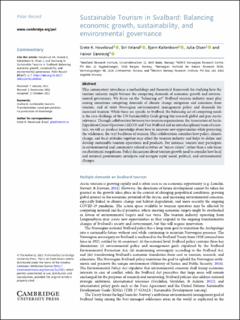Sustainable Tourism in Svalbard: Balancing economic growth, sustainability, and environmental governance
Peer reviewed, Journal article
Published version

Åpne
Permanent lenke
https://hdl.handle.net/11250/3067188Utgivelsesdato
2021Metadata
Vis full innførselSamlinger
- Publikasjoner fra CRIStin - NINA [2364]
- Scientific publications [1392]
Originalversjon
10.1017/S0032247421000668Sammendrag
This commentary introduces a methodology and theoretical framework for studying how the
tourism industry might balance the competing demands of economic growth and environ mental governance. We focus on the “balancing act” Svalbard tourism industry must play
among sometimes competing demands of climate change mitigation and emissions from
tourism, and of strict Norwegian environmental management policy and demands for
increased tourism. While these are specific to Svalbard, the balancing act of competing needs
is the core challenge of the UN Sustainability Goals giving this research global and pan-Arctic
relevance. Through collaboration between two tourism organisations, the Association of Arctic
Expedition Cruise Operators (AECO) and Visit Svalbard and an interdisciplinary team of scien tists, we will co-produce knowledge about how to innovate new opportunities while protecting
the wilderness, the very backbone of tourism. This collaboration considers how policy, climate
change, and local attitudes together may affect the tourism industry and helps to define and
develop sustainable tourism operations and products. For instance, tourists may participate
in environmental and community-related activities or “micro safaris” rather than a sole focus
on charismatic megafauna. Policy discussions about tourism growth need to consider how local
and national governments anticipate and navigate rapid social, political, and environmental
changes.
